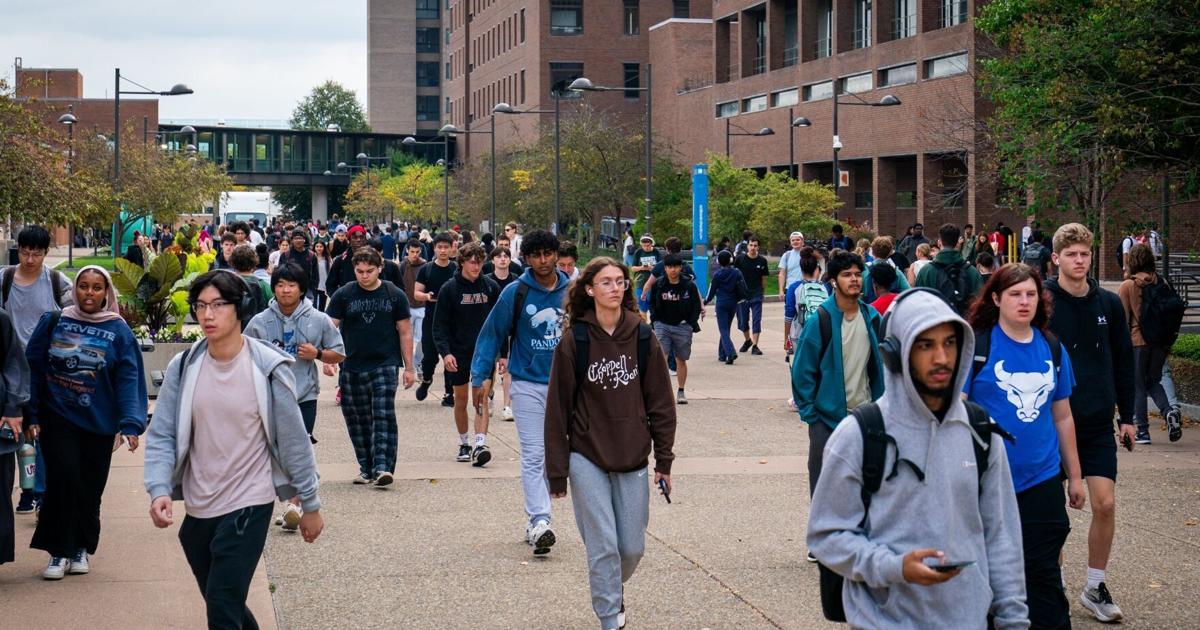
A University at Buffalo undergraduate education costs more than ever, but it delivers a return on investment of nearly $2.3 million over a span of 40 years for degree holders, leading the way among colleges and universities in Western New York.
Not far behind were D’Youville University at $2.16 million, SUNY Geneseo at $2.1 million, Daemen, Canisius and St. Bonaventure universities at $1.98 million, and Niagara University at $1.91 million, according to the Georgetown University Center on Education and the Workforce.
The center analyzed the return on investment of 4,600 colleges and universities across the country by calculating the average cumulative earnings of a graduate and subtracting from that the net costs of attending the university for five years. UB’s average annual costs were $20,470 and its median annual earnings for students after 10 years of first enrolling at the institution were $70,814, according to the latest College Scorecard data.
So, in the case of UB graduates, the return on investment 10 years after initial enrollment is $215,000, the Georgetown study found. After 20 years, the return on investment improves to $905,000 and after 40 years, it is $2,285,000.
UB was fourth among state institutions, behind SUNY Maritime College, which had a 40-year return of $3.1 million; Binghamton University at $2.69 million; and Stony Brook University at $2.47 million.
Albany College of Pharmacy and Health Sciences is No. 1 in New York State with a 40-year return of $4.45 million. The highest return in the nation was $4.56 million at the University of Health Sciences and Pharmacy in St. Louis.
It would make sense for a large university such as UB to have a bigger return on investment than other smaller institutions in a region, said Jeff Strohl, research professor and director of the Georgetown University Center on Education and the Workforce.
Larger, well-known universities are more likely to have graduates competing in the national labor market and moving for jobs in high wage labor markets such as San Francisco and New York City, said Strohl.
“Most of the ROI studies aren’t able to control for that,” he said.
Among Western New York institutions, Continental Beauty School, which offers a certificate program, was at the bottom for ROI after 40 years, with $816,000. The beauty school’s 10-year return of $182,000, though, outpaced those of 13 colleges and universities that offer either associate or bachelor’s degrees or both.
Strohl said the ROI data generally shows that if you go to college, “on average it’s going to pay off.”
But it does take time, somewhere between 10 and 15 years in the labor market for bachelor’s degree recipients, and “not everybody is average,” acknowledged Strohl.
So, it’s not the guarantee it was a generation ago, before college costs climbed so high that many high school graduates and their families began questioning whether a degree was still worth pursuing.
In Western New York, the best short-term returns came from Erie 2 BOCES practical nursing, where students on average were ahead by $382,000 a decade after enrolling in the program. Trocaire College, which also has a focus on nursing, was second at $331,000.
The lowest return after 10 years was $107,000 at Houghton University in Allegany County.
None of the colleges and universities in the region had a negative return on investment, according to the report.
The Georgetown Center on Education and the Workforce released its first ROI report in 2019. The annual studies rely on data collected by the federal government for the U.S. Department of Education’s College Scorecard, which tracks variables such as average annual cost of a college or university, median earnings, student debt and graduation rates.
The College Scorecard was born out of former President Barack Obama’s attempts to address growing concerns about student debt and college affordability. Obama visited UB in 2013 and called higher education “the single best investment you can make in your future,” while also acknowledging that attending college “has never been more expensive.”
The Obama administration also proposed a ratings system to steer federal tax dollars toward institutions that provide the best value for students but ultimately backed away from that idea in favor of the College Scorecard, which debuted in 2015.
The scorecard has since spawned various independent analyses of return on investment. The Georgetown Center on Education and the Workforce, for example, also examines ROI for various academic programs and by student income levels.
Strohl said the institutional ROI rankings take a broad-brush approach and should be used by students and families only as one factor among many in helping them find a college or university that fits.
Students probably should first explore their academic interests and then examine schools’ return on investment at the program level, he said.
Roughly 15% to 20% of bachelor’s degrees don’t have a positive return on investment.
But even within the same institution, there can be a wide spectrum of earnings for bachelor’s degrees, he said.
“When we’re talking about ROI, we’re talking about these highly aggregated averages that miss the nuances below the surface,” said Strohl. “The student needs to do a lot of detective work here.”
Strohl said the debate over whether college is worth the upfront costs has become muddied by changes in labor markets that have led to some struggles for recent college graduates.
But a recent degree earner not finding a job immediately in his or her field of study doesn’t mean the degree is worthless, he added.
“That’s not a very good way to meter if the investment is good or not,” he said.
Instead, he said, the view should be that once the costs of the degree are paid, 25 to 30 years of a degree recipient’s career cycle are all profit.
“The coincidence of when you start to profit from the investment is also the same time when life costs go up – marriage, kids, house, all those things,” said Strohl.
Want to see more like this?
Get our local education coverage delivered directly to your inbox.
* I understand and agree that registration on or use of this site constitutes agreement to its user agreement and privacy policy.
Jay Tokasz
Reporter
Get email notifications on {{subject}} daily!
Your notification has been saved.
There was a problem saving your notification.
{{description}}
Email notifications are only sent once a day, and only if there are new matching items.
Followed notifications
Please log in to use this feature
Log In
Don’t have an account? Sign Up Today



